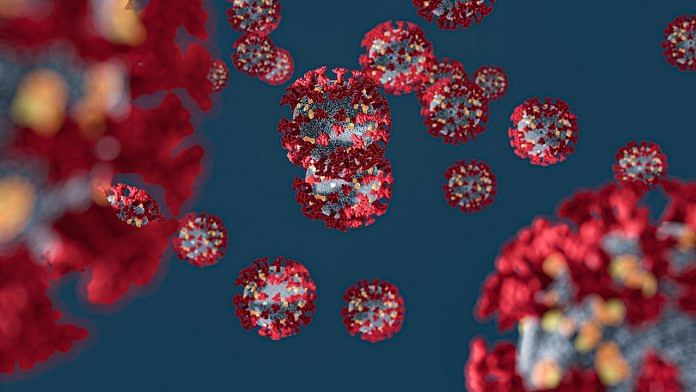New Delhi: The reason for the devastating transmission and infection of Covid-19, as compared to common-cold causing coronaviruses, is due to the high interaction energy and area between the spike protein of the SARS-CoV-2 virus and the human ACE2 receptor protein, seen as the entry point for the coronavirus to hook onto and infect a wide range of human cells, a study by IIT Madras has found.
The team conducted an analytical study between three viruses that have affected humankind — SARS-CoV, which appeared in China in 2002; the NL63, a strain of common-cold causing coronavirus first identified in the Netherlands in 2004, and the SARS-CoV-2 which triggered the current Covid-19 pandemic.
The researchers found that the interaction area between the spike protein of viruses and ACE2 in the human body plays a key role in deciding the severity and transmission potential of coronaviruses.
ACE2 binding protein, also known as the angiotensin-converting enzyme 2, provides the entry point for the coronavirus to hook onto and infect a wide range of human cells. In simpler terms, this protein acts as the doorway for the coronavirus into the human body. ACE2 is present on the linings of many cell types and tissues including the lungs, heart, blood vessels, kidneys, liver and gastrointestinal tract.
The study titled ‘Why are ACE2 binding Coronavirus strains SARS- CoV/SARS- CoV 2 wild and NL63 mild?’ was published in the scientific journal Proteins: Structure, Function, Bioinformatics on 16 November 2020. The IIT researchers shared their findings this Monday.
The research team was led by Prof. M. Michael Gromiha, Department of Biotechnology, IIT Madras; Bhupat and Jyoti Mehta of the School of Biosciences, IIT Madras; and Dr Puneet Rawat and Dr Sherlyn Jemimah, research scholars from IIT Madras. The team collaborated with Prof. P.K. Ponnuswamy, former vice-chancellor, University of Madras.
‘SARS-CoV-2 infection most severe’
The researchers wanted to understand why recent epidemic-causing coronaviruses like SARS-CoV and SARS-CoV-2 were more deadly than the common-cold causing coronaviruses like NL63.
To do this, they studied how the spike proteins of different virus strains interact with the ACE2 receptors of human cells and how this interaction affects their transmission potential and severity of the disease.
They found that the interaction area between spike protein of viruses and ACE2 in the human body, surrounding hydrophobicity and interaction energy, play a key role in deciding the severity and transmission potential of coronaviruses. Hydrophobicity is the property of being repelled by water.
“We found that the SARS-CoV-2 infection is more severe by studying its properties. We found that this latest mutation of the virus has high interaction energy … this means that the spike protein of the virus and ACE2 have a large common area and a tight bond,” Dr Micheal Gromiha, the lead researcher of the study, told ThePrint.
“For example, when two bodies are in contact, high interaction energy between them would mean that they have large common areas,” he added. “The severity of the disease is high when the strength of binding between the two surfaces is high.”
The team also found that NL63 has unique ACE2 binding sites when compared to SARS-CoV and SARS-CoV-2.
According to the researchers, understanding of host-pathogen interactions will help find ways to reduce the gravity of the severe disease-causing coronaviruses and develop effective therapeutic interventions.
“The similarities and differences in the spike proteins of the three viruses indicated in this study may help researchers to deeply understand the structural behaviour, binding site properties and etiology of ACE2 binding, accelerating the screening of potential lead molecules and the development or repurposing of therapeutic drugs,” the authors stated in the study.
(Edited by Arun Prashanth)
Also read: ‘Double mutant, triple mutant, Bengal lineage’ — Covid variants driving India surge decoded
